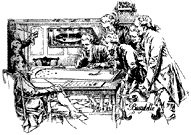
The great ideas behind these early games revolved around their perceived
fun and playability-- no table or board could be too hard or too easy.
Someone had to strike a balance, figure the details out, determine the
play, set the odds of winning a special or wager. This was the
designer.
Though early games had no coin slide, gambling most likely took place
with saloon keepers booking bets on games. Since skill determines a
players balltime and level of achievement, owners of games wanted to
offer games that were easy to use but hard to overcome; as businessmen
their goal was sustained profitability. For the designer then, laying
out a bagatelle table was to walk a fine line between the needs of the
game owner and its user. This line exists today and is part of the
mystique, the challenge of Pinball design. The balancing act of
commercial and amusement goals makes some pinball companies hallmarks of
success and pushes others to die a bloody death and fall off the face of
the Earth. The designer is the primary visionary in the creation of the
well balanced game and through collaborative efforts with technicians,
fabricators, and artists the balance is struck.
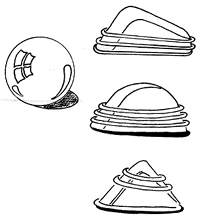 For me the epic of the steel ball began on a long weekend at the Holiday
Inn in Buffalo. They had a row of old games, all on dime play and
brilliantly calling to me. I was wonder struck and in awe of these
gorgeous machines. Designers, even in their youth, are naturally
curious, and I was soon building my own tables out of wood and nails
during school. I always had time to create new nail patterns on my
sketch pad and rush back home to construct that days version. Little did
I know that the pinball pioneers had done the same thing, but back in
the 30's. I had found my calling.
For me the epic of the steel ball began on a long weekend at the Holiday
Inn in Buffalo. They had a row of old games, all on dime play and
brilliantly calling to me. I was wonder struck and in awe of these
gorgeous machines. Designers, even in their youth, are naturally
curious, and I was soon building my own tables out of wood and nails
during school. I always had time to create new nail patterns on my
sketch pad and rush back home to construct that days version. Little did
I know that the pinball pioneers had done the same thing, but back in
the 30's. I had found my calling.
After school I easily adapted my architectural instruction to drawing
out playfield designs for commercial pinball. Drawing was not new to
me, and sketching wonderfully curvilinear and sublimely subjective ball
paths was too much to let go. I contacted the Bally Manufacturing
Company on Belmont Avenue in Chicago and asked for a tour. I knew full
well that their chief engineer was not really interested in any "new"
ideas or industrial designers, but a tour would be awesome anyway. I
came to Chicago and after showing my sketches over a hearty steak,
managed to snag an entry level job in the design engineering department.
I was in and learning the ropes from the pinball gods.
 Engineering departments are magical and secretive places in the pinball
industry, and tales of clearing three security guards, two passcode
entries and surly receptionists are common. Game development takes at
least a year from original sketch to production. Hush, hush is the key.
A novel device or new technology leaked out and quickly adapted by a
competitor could yield huge fiscal damage and leave those responsible in
ruin.
Engineering departments are magical and secretive places in the pinball
industry, and tales of clearing three security guards, two passcode
entries and surly receptionists are common. Game development takes at
least a year from original sketch to production. Hush, hush is the key.
A novel device or new technology leaked out and quickly adapted by a
competitor could yield huge fiscal damage and leave those responsible in
ruin.
The standard pinball table is made from 7-ply white birch, exactly
20-1/4" x 46" and has up to 14 screens of lustrous UV cured ink on top.
Crystal-like jewels and inserts adorn the play surface and show the
player what to shoot for with his chrome-steel ball of 1-1/16" diameter.
Typical games have 200 parts of which 150 are unique. Ever since the
30's most tables and schematics were drawn on sheet canvas or newly
invented vellum. All work was methodically drawn by hand with pencil or
India Ink. Circuit diagrams, metal stampings, springs and the immortal
electric bumpers all came from rigid engineering standards. Games were
completed faster than today, but those past pinballs were far less
complex.
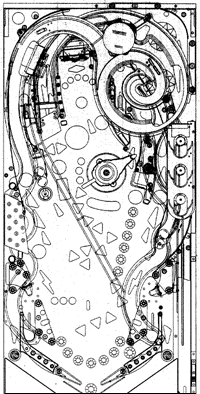 The hardest and fundamentally most important design choice is the theme
to begin with. Every game starts there and in some cases ends there too.
A poorly rendered theme can trash a game's success. On my design team
we use universal topics or concepts. alienation of any group or
individual is too great a risk, so our games reflect a generalness.
Once the theme is decided, such as "Theatre of Magic", we sit down for
brain storming sessions and team lunches. Every tidbit is written down
in my master book, one for each game, so nothing gets lost.
The hardest and fundamentally most important design choice is the theme
to begin with. Every game starts there and in some cases ends there too.
A poorly rendered theme can trash a game's success. On my design team
we use universal topics or concepts. alienation of any group or
individual is too great a risk, so our games reflect a generalness.
Once the theme is decided, such as "Theatre of Magic", we sit down for
brain storming sessions and team lunches. Every tidbit is written down
in my master book, one for each game, so nothing gets lost.
Concurrently I begin a new Autocad drawing, laying out the main
playfield. The whole game is rendered this way and layers are created
for all parts on a typical playfield. Layer designations usually reflect
the actual physical property of the part designed so VACU1 becomes the
vacuum formed ramps and METL3 includes the stainless steel ballguides
rendered in blue hues. The baseline of the drawings is the rectangular
outline of the playfield with positions for the flippers and outhole
trough system. The flipper position had changed little from game to game
since it's inception in the late 40's. A change here would adversely
affect the players comfortable control and allow too much variance in
game to game play.
This process differs from when I first started in the industry. My
early games were all hand drawn on large mylar sheets accompanied by
notes and details. In the initial stages of design, this method is
still better than using the computer. Laying out a curvy shot on a 21"
monitor is decidedly less revealing than using a beam compass or French
curve on a full-size sheet. The feel can get lost on the computer so I
still draw all the first key shots and ball paths by hand and transmit
critical tangent arc points into Autocad via a coordinate base. The best
of both worlds.
In many of today's themed games, an overall look or concept will be the
next primary focus. For example, in "Theatre of Magic" we placed the
player in an old theatre hall. The ball ramps became "stairs" and the
main part of the play area was the magicians stage. Props like the
"Tiger Saw" and "Magic Trunk" were placed right in the center of the
stage. More than just for looks, these "toys" were fully kinetic
mechanical designs using motors, rotational molded parts and
light-optics to sense and interact with the pinball. At this point a
side elevation allows me to start placing in some of these devices.
Pinball tables have a sheet of glass covering the playfield, a barrier
under which all mechanical parts must fit. This is design limitation, in
some cases, forces the change or removal of a great feature.
After a rough Autocad design is in place I move to foamcore and styrene
to mock-up a model. The model will show me some of my concepts in a real
world setting, yet allow me to work it up in a matter of days. If I
went right to steel and wood as my first explorative mediums the
development time would quadruple. A foamcore model allows me to roll a
ball around, adding graphics and illumination to create a sense of
reality. Many games today use plastic decorative pieces to enhance the
realism for the theme. Now is when these molded plastic parts can be
sculpted, often by artists such as Chicago's Jerry Pinsler, and fit in
place. For "Theatre of Magic," a Magic Trunk was created-- it sits atop
an axial rotating mechanism, magnetically levitates a ball and makes it
disappear.
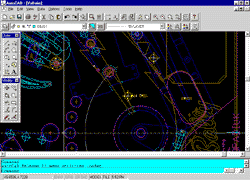 Upon seeing many of the preliminary ideas modeled I revise my main
Autocad layout and tighten things up, especially flipper shots and ball
flow. A typical drawing will have up to 25 separate layers detailing
everything from ramp angles to bumper placement. With a revised drawing
I can begin to focus my team to our first milestone, the "whitewood".
The whitewood refers to the early models we build to test components and
get a real feel for the game. Pinball is still very much a kinetic
artform and simulating anything on the computer always falls a bit
short. The whitewood takes shape about 4 months from the project start.
It lights up, bumps and kicks just as a production model would.
Upon seeing many of the preliminary ideas modeled I revise my main
Autocad layout and tighten things up, especially flipper shots and ball
flow. A typical drawing will have up to 25 separate layers detailing
everything from ramp angles to bumper placement. With a revised drawing
I can begin to focus my team to our first milestone, the "whitewood".
The whitewood refers to the early models we build to test components and
get a real feel for the game. Pinball is still very much a kinetic
artform and simulating anything on the computer always falls a bit
short. The whitewood takes shape about 4 months from the project start.
It lights up, bumps and kicks just as a production model would.
The concept, the artistic execution and the computer drawings all evolve
along with the prototype.the concept along with software support and
early artistic concepts. We start adding more real elements like
stainless steel and Lexan. Up to four iterations of the whitewood may
be produced during this phase. Using a computer has made this
exploratory process a bit cleaner than the previous mylar drawing
techniques. And although real parts never quite match up with what is
on-screen, our Autocad drawing becomes the master footprint and
reference for all work. Changes and revisions are implemented at a
faster rate than before, allowing us more freedom and room for
exploration in the prototyping process.
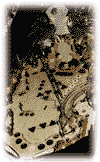 The physical testing grounds of the whitewood model speaks volumes to us
as a design team, but because of the delicate physics of game play it
can never fully reveals how the ball will roll in the finished machine.
So we take our engineering and design work as far as possible, then
release the drawings to build 15 early production prototypes. This
happens at around month 7 of the design cycle. All parts are made and a
dedicated team assembles these fully adorned games with complete art,
chrome plated ballguides, full sound and software. This literally
transforms our sketches and ideas and models into a thing of beauty--
one that commands attention. For the team and myself it is a real morale
builder to see the game take form. After rigorous rounds of testing and
some final tweaks the final manufactured version goes into mass
production and a few months later the games are shipped around the
globe. Most factories have upwards of 1000 people dedicated to the
production process, and even more in the distribution channels.
The physical testing grounds of the whitewood model speaks volumes to us
as a design team, but because of the delicate physics of game play it
can never fully reveals how the ball will roll in the finished machine.
So we take our engineering and design work as far as possible, then
release the drawings to build 15 early production prototypes. This
happens at around month 7 of the design cycle. All parts are made and a
dedicated team assembles these fully adorned games with complete art,
chrome plated ballguides, full sound and software. This literally
transforms our sketches and ideas and models into a thing of beauty--
one that commands attention. For the team and myself it is a real morale
builder to see the game take form. After rigorous rounds of testing and
some final tweaks the final manufactured version goes into mass
production and a few months later the games are shipped around the
globe. Most factories have upwards of 1000 people dedicated to the
production process, and even more in the distribution channels.
Today pinball machines are manufactured and designed by historic
companies like Williams, Bally, and the recently reorganized Gottlieb,
with new entries from Sega and Capcom. Since the 1930's the Midwest has
been the hub for the pinball industry. Its central location and
abundant supplies spawned Bally Manufacturing in1931 and Williams in the
early 40's. Innovations like the spring-loaded ball shooter, 1" ball
and 21" x 42" tablesize were popularized there over 65 years ago and are
still used now.
Even though Technology has significantly enhanced both game play and
production since those times, the role of the designer has remained
constant. From a blank sheet will emerge a new adventure or mystery to
be played out by a hard steel ball in some unbridled land or time. From
the working and re-working of a prototype comes game play that coaxes
and challenges. And somewhere deep in the whole process that
undefinable feel of Pinball is born and then delivered into this world
by the hands of the design team.
John Adam Popadiuk, Designer @ Williams Electronics Games Inc.
(makers of Bally and Williams Pinball Machines)
email: jpopadiuk@wms.com
All Images Copyright © 1997, WMS Industries. "Attack from Mars", and
"Theatre of Magic" are trademarks of Midway Manufacturing Company, Inc.,
"Tales of the Arabian Nights" is a trademark of Williams Electronics
Games, Inc.
 experience, imparting a sublime romantic allure to the game. On a flying
carpet you can travel to Baghdad and relive the
"Tales of The Arabian Nights"
or battle a voluptuous temptress in her "Theatre of Magic".
Surviving that, you could encounter a marauding band of aliens during an
"Attack From Mars." Pinball Machines, the marvels of the mechanical age
await to transport you there. A designer, leading a team of no less than
ten other spirited alchemists, creates the means for these mystical
journeys.
experience, imparting a sublime romantic allure to the game. On a flying
carpet you can travel to Baghdad and relive the
"Tales of The Arabian Nights"
or battle a voluptuous temptress in her "Theatre of Magic".
Surviving that, you could encounter a marauding band of aliens during an
"Attack From Mars." Pinball Machines, the marvels of the mechanical age
await to transport you there. A designer, leading a team of no less than
ten other spirited alchemists, creates the means for these mystical
journeys.





